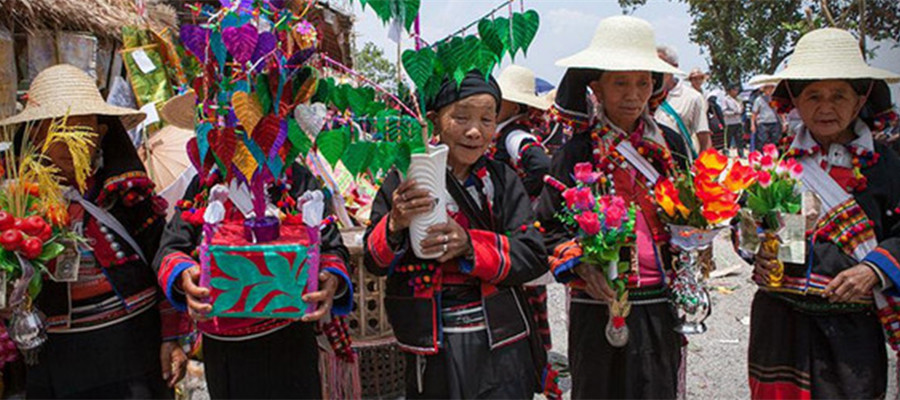Zuobai Festival of Deang Ethnic Minority
Basin Introduction
- Chinese Name: 德昂族做摆/赶摆
- English Name: Zuobai Festival of Deang Ethnic Minority
Zuobai Festival(做摆) is Deang ethnic minority’s religious festival in Dehong and Xishuangbanna(西双版纳). The date of the festival is not fixed, generally once a year. Zuobai Festival consumes a lot, so it is held once every three or four years when the economic declines. Deang people believe that Zuobai Festival can bring a bumper grain harvest, thriving domestic animals and a peaceful village. Before the festival, sponsors needs to prepare large quantities of rice, meat, oil, papers, candles, joss-sticks and several Buddha statues. From days before the festival to the end, numerous people who are from near and far villages will join it. Sponsors provide warm reception, accommodation and food. On the first day of the festival, people go to the Buddhist temple to greet the Buddha with gongs and drums. People hold a carnival gala as the statue arrives. The next morning a rite of worshipping Buddha is held to listen to the sermon. After the breakfast to the afternoon, people parade around the Buddhist temple with gongs and drums, scattering popcorn and setting off firecrackers. After the dinner, people still rejoice with wild excitement, but it’s not as lively as last night. On the third day, guests are leaving one after another. Villagers dedicate all tributes and the statue of Buddha to the temple. At last, people set up a high perch with a banner to end the festival with a feast.

Origin
The origin of the Zuobai Festival is intertwined with the De’ang people’s cultural history and their reverence for ancestors and deities. It is believed to have evolved from ancient rituals related to agricultural practices, the changing of seasons, and the instilling of spiritual beliefs. Over time, the festival has become a time to honor the Buddha, seeking blessings for protection and warmth during the winter months.
Customs
- Construction of the White Pagoda:
- A central aspect of the festival is the creation of a tall structure made from white firewood, known as a “white pagoda” or “white tower.” This symbolizes warmth and respect for spiritual entities, particularly the Buddha.
- Lighting the Fire:
- In the evening of the festival, the white pagoda is set ablaze. This ritual signifies the offering of warmth to the Buddha, conveying the community’s wishes for protection from the cold and blessings for the coming year.
- Offerings and Prayers:
- Participants may make offerings of food, fruits, and incense at the foot of the pagoda before lighting the fire. This is a way to show gratitude and seek blessings from their ancestors and spiritual beings.
Significance
- Cultural Identity: The Zuobai Festival serves as a vital expression of De’ang cultural identity, preserving traditions, customs, and beliefs for future generations.
- Spiritual Reflection: It emphasizes the De’ang people’s connection to spirituality, showcasing their practices in honoring ancestors and the Buddha.
- Social Cohesion: The festival promotes unity within the community, reinforcing social bonds and shared values among the De’ang people.
Local Activities
- Community Gatherings:
- Villagers come together to participate in the festival, fostering a sense of belonging and community spirit. Gatherings often involve sharing food and engaging in cultural exchanges.
- Traditional Performances:
- Local artists may perform traditional songs and dances that reflect De’ang folklore, history, and values. These performances provide entertainment and serve to educate younger generations about their heritage.
- Feasting:
- Food plays a critical role in the festival. Families prepare traditional dishes, allowing people to experience the flavors of De’ang cuisine while enjoying communal meals.
- Games and Competitions:
- Various games and competitions may also be organized, adding an element of fun and interaction among participants, particularly for the younger generations.

 7 Days GolfingTour
7 Days GolfingTour
 8 Days Group Tour
8 Days Group Tour
 8 Days Yunnan Tour
8 Days Yunnan Tour
 7 Days Shangri La Hiking
7 Days Shangri La Hiking
 11 Days Yunnan Tour
11 Days Yunnan Tour
 6 Days Yuanyang Terraces
6 Days Yuanyang Terraces
 11 Days Yunnan Tour
11 Days Yunnan Tour
 8 Days South Yunnan
8 Days South Yunnan
 7 Days Tea Tour
7 Days Tea Tour
 8 Days Muslim Tour
8 Days Muslim Tour
 12 Days Self-Driving
12 Days Self-Driving
 4 Days Haba Climbing
4 Days Haba Climbing
 Tiger Leaping Gorge
Tiger Leaping Gorge
 Stone Forest
Stone Forest
 Yunnan-Tibet
Yunnan-Tibet
 Hani Rice Terraces
Hani Rice Terraces
 Kunming
Kunming
 Lijiang
Lijiang
 Shangri-la
Shangri-la
 Dali
Dali
 XishuangBanna
XishuangBanna
 Honghe
Honghe
 Kunming
Kunming
 Lijiang
Lijiang
 Shangri-la
Shangri-la
 Yuanyang Rice Terraces
Yuanyang Rice Terraces
 Nujiang
Nujiang
 XishuangBanna
XishuangBanna
 Spring City Golf
Spring City Golf
 Snow Mountain Golf
Snow Mountain Golf
 Stone Mountain Golf
Stone Mountain Golf














